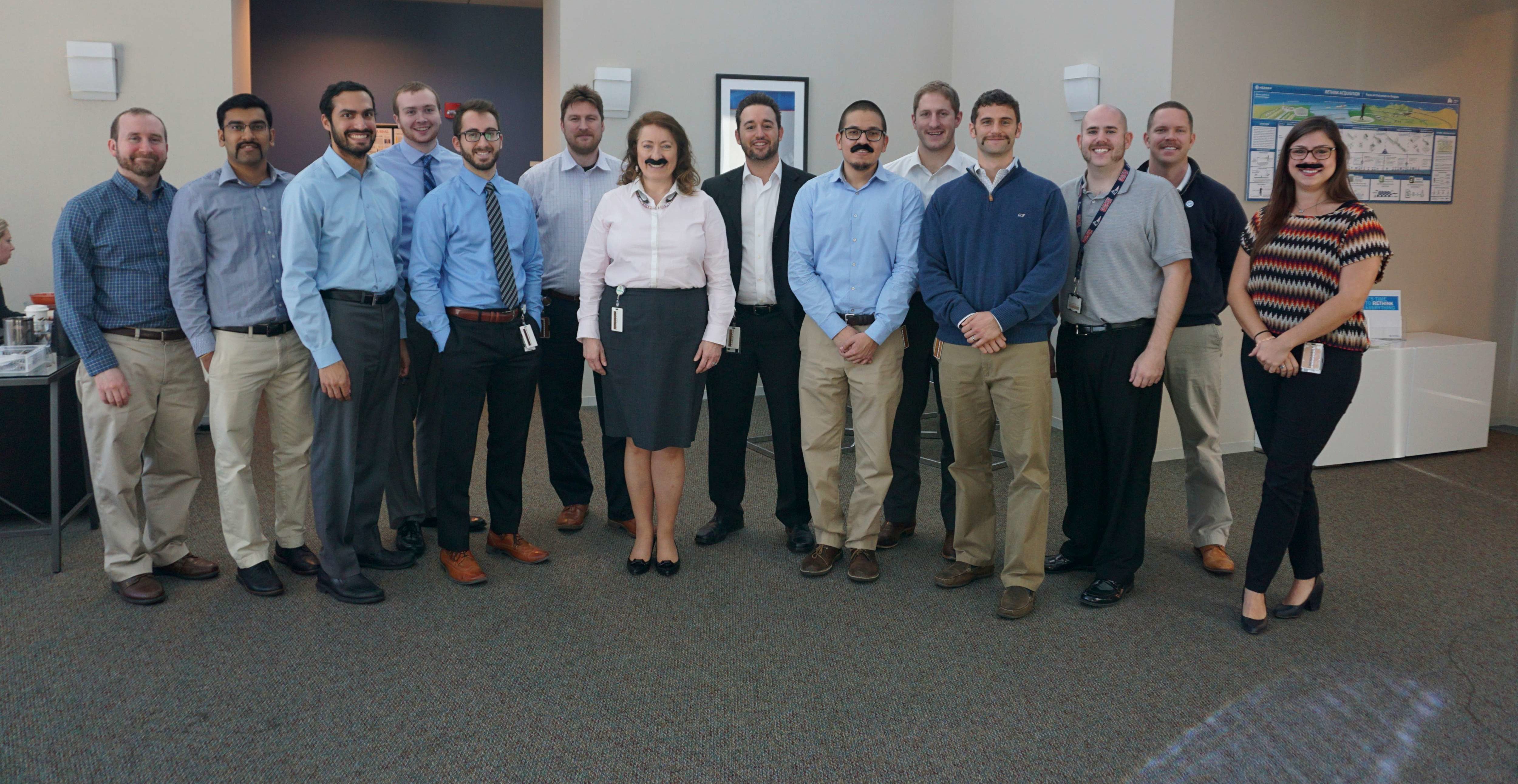The Innovation Circle
Jeffrey Herren takes time to get to know new employees at Herren Associates through a monthly leadership breakfast, where he learns about their personal lives, rather than just focusing on business. Herren is also directly involved in performance reviews for each employee, offering personalized feedback. To offer employees a chance to impact their communities, Herren Associates created a corporate social responsibility program that provides hands-on volunteer opportunities and pro-bono consulting projects. Fostering a healthy lifestyle is important to Herren Associates as well, and the company participates in 5ks, kickball leagues and the Herren Fit Fest together.
01 The Client
A nonprofit operating a warehouse with donations from manufacturers and retailers needed Herren’s help to support $1 billion in product donations annually. (Learn more about our community partner’s mission here: https://good360.org/)
02 The Challenge
The client had a strategic goal of reaching $1B in annual production donations, but they were unsure if their warehouse could process enough product, so they asked Team Herren to evaluate and develop improvements for their main (Omaha) warehouse and corporate office.
03 The Solution
Team Herren spent two weeks onsite conducting a thorough analysis of current warehouse operations, developed metrics tools to expedite the marketing and sales of donations, and addressed debranding, aged merchandise, administrative fees, and website advertising revenue issues. Using traditional industrial engineering techniques and methodologies, Team Herren began developing new warehouse layouts and product flows. Additionally, Team Herren created new SOPs to prevent bottleneck processes. In the second week, Herren analyzed the data collection practices for the Omaha warehouse, the future ERP implementation strategy, and the corporate operations. Herren delivered a data collection plan that included key metrics and visuals to help capture and understand process trends. This was the basis for the future ERP implementation strategy. Finally, at a high level, Herren reviewed corporate strategies in order to provide several recommendations
04 The Result
Team Herren developed seven actionable recommendations in order to maximize operations at the warehouse, with the potential to reach $1B in new product donations in the future.
01 The Client
The client’s mission is to use food as a tool to strengthen the community, offering job training, healthy food distribution, and local farm partnerships to provide path-breaking solutions to poverty, hunger, and poor health. (Learn more about our community partner’s mission here: https://dccentralkitchen.org/)
02 The Challenge
The client purchases raw food ingredients to create meals at DC public schools and community aid programs. These items are delivered to the Nutrition Lab daily and stored in pantries, freezers, and coolers. The procurement manager was currently keeping track of inventory by performing a monthly visual inspection. The client experienced over-ordering and waste caused by the difficulty in tracking these products, their inventory levels, and expiration dates.
03 The Solution
Team Herren mapped the baseline procurement process to define the scope of the proposed inventory control system and conducted interviews to determine the stakeholder requirements. Next, the team researched inventory control best practices and created a plan for implementing these practices at the client’s facility. Their research resulted in the decision to create an Access database for the client to manage and track inventory metrics.
04 The Result
Herren’s inventory control tool allows the client to create orders, track order receipts, and identify expiring items. The team also created a complementary guidebook to ensure successful implementation of the inventory control database. Finally, the team standardized the procurement process across several of the client’s programs and defined roles and responsibilities for the procurement, receiving, and production teams. The automated tool reduces waste through overspending, reduces the administrative time of purchasing the food, and ensures that the optimal amount of food is being stored and delivered from the facilities.
-DCCK Logistics Project-
01 The Client
The client’s mission is to use food as a tool to strengthen the community, offering job training, healthy food distribution, and local farm partnerships to provide path-breaking solutions to poverty, hunger, and poor health.
02 The Challenge
The client’s logistics department includes their logistics manager and 12 drivers who perform donation pick-ups and drop-offs throughout the DC area on a daily basis. They receive their schedule from the procurement manager who coordinates with the agencies providing or receiving goods. Most of these stops are provided based on a routine schedule; however, the transportation team does receive unexpected pick-up requests throughout the day. Often these pick-ups are non-value-added as the value does not exceed the cost of performing the pickup. This contributes to overtime pay for drivers who are kept on duty longer each day.
03 The Solution
Team Herren conducted several stakeholder interviews with the logistics team to identify and map the daily process for receiving orders, assigning them to the drivers, and performing the stops. Next, the team collected delivery and pick-up routes and delivery tickets to assess the distance traveled against the value of goods received. Finally, the team performed root cause analysis to identify the source for non-value-added pickups. The team found that there were no criteria for preventing low quantity and poor quality goods from being picked up, and no cost/benefit analysis for identifying the value of a pickup.
04 The Result
Herren worked with the client to establish stringent criteria for pickups, and provided them a cost/benefit calculator to ensure each pickup provided value. Team Herren documented the new process which includes the use of these products for receiving and accepting pick-ups. The criteria are communicated on the website for interested donors, and the process is used by the procurement manager to ensure pick-ups are value added. The new supply routes Team Herren created will reduce delivery time, missed shipments, and drive down costs by reducing the number of hours drivers are needed. The projected impact of the team’s work is over $10K a year in cost savings.
The Client
A nationally recognized, award-winning educational organization providing affordable, quality education; professional development to educators; and family support services in a bilingual and multicultural environment to more than 2,400 low-income children and families. Herren is proud to announce a 5 year partnership with CentroNia, where we will jointly embark in achieving the organization’s strategic priorities to expand and deepen their service to families in the DC-region. (Learn more about our community partner’s mission here: https://centronia.org/)
The Challenge
The client’s executive board would like to periodically review the financial health of each of the programs in order to make effective business decisions. There are also inefficiencies associated with the admissions / attendance process including reporting errors that have resulted in over $150,000 in lost funds during the past fiscal year.
The Solution
Team Herren has taken a strategic approach to address both initiatives and started by gaining a better understanding of the client’s mission and core values. The team also worked with the executive board and admissions staff to outline goals and key performance indicators to measure success. These goals were used to propose dashboard ideas and identify the data necessary to provide an accurate snapshot of program financials. The goals also provided insights into the admissions process, which has allowed the team to focus on key problem areas and opportunities for improvement.
The Result
Team Herren built an executive dashboard which will break down revenues and expenses for each of the client’s programs. By having the capability to look into the financials each month, this will allow the executive board to make data-driven decisions to best steer the organization for continued success. Additionally, the team will use the admissions process as a model to demonstrate how to use various process improvement tools and techniques. As the client continues to evolve as an organization, they can use their new process improvement skills to address other challenge areas and drive efficiencies throughout other aspects of the organization.
interviews to determine the stakeholder requirements. Next, the team researched inventory control best practices and created a plan for implementing these practices at the client’s facility. Their research resulted in the decision to create an Access database for the client to manage and track inventory metrics.
In a 2013 DefenseNews op-ed, Herren Associates President Jeffrey M. Voth argued that it is possible for organizations to thrive despite cutbacks in defense spending by realigning to focus on delivering outcomes. As the pendulum begins to swing back toward a higher defense spending level, outcomes-based strategy continues to be an essential method through which organizations can make the best use of every dollar, standing out from competition and achieving breakthrough results.
Post-9/11 Pentagon spending peaked in 2009 at more than $691 billion — a combination of the Defense Department’s request for basic funds and the supplemental request it made for wartime spending. 2015’s spending level, $560 billion, was the lowest in nearly 10 years.
“Conventional wisdom suggests that—with the U.S. military presence having wound down in Afghanistan and Iraq over the last five years—U.S. military spending will continue to decline,” wrote Henry To, chief investment officer at CB Capital Partners in January of 2016. “In actuality, this is far from the truth.”
With the passage of the National Defense Authorization Act for Fiscal 2017, the U.S. is set to spend $574 billion on national defense. Given that personnel levels continue to fall, this more robust spending level indicates an increased focus on procurement and research, development, test, and evaluation (RDT&E).
Given these new opportunities, how can our nation’s leadership adopt new ways of thinking as they invest in America’s national defense? The answer: they must realign their decision-making processes using an outcome-based mindset.
Until recently, the performance of defense programs has been judged largely on a series of inputs, activities, outputs, and performance relative to budgetary benchmarks. This approach, however, has come under fire, and the 2017 NDAA will split the position of Under Secretary of Defense for Acquisition, Technology, and Logistics USD (AT&L) into two positions. One executive will focus on innovation, while the other focuses on acquisition. One of the limiting factors behind many past reform initiatives has been the preoccupation with a maze of processes and guidebooks developed to simply follow rules, lacking clarity about what benefits are actually realized from each taxpayer dollar.
Defense programs are under increasing pressure to produce results. “Innovation cannot be an auxiliary office at the Department of Defense. It must be the central mission of its acquisition system,” said Senator John McCain, chairman of the Senate Armed Services Committee (SASC) in a recent statement.
Review of our nation’s defense posture recognizes the importance of outcomes for effective and responsible management, because an outcome approach requires a strategic focus on what matters to the warfighter.
What is an outcome-based mindset?
Outcome orientation represents a fundamentally different way of thinking and managing programs across all aspects of the defense acquisition system and how it relates to its major stakeholders. To be effective, organizations will need to rethink their current operating model at all levels.
Change of this nature is not easy – both a top-down and bottoms-up approach is needed. Strong and direct support from legislators and program executives will be essential to provide legitimacy and support. But unless there is also support throughout the defense acquisition system – from policy formulation to operational execution – an outcome focus runs the risk of becoming another administrative reporting exercise instead of a substantive change in thinking of how a program is managed throughout the acquisition lifecycle.
To be sure, outcomes are longer term in nature and are typically influenced by a variety of factors, many external to an individual program manager. They tend to be more difficult to quantify than activities or outputs. Given that achievement of outcomes may in part depend upon factors beyond the direct control of a program or its manager, a different approach may be required other than simply measuring inputs or outputs.
Outputs are important products and artifacts – the “what.” Output metrics are inwardly focused to assess the effectiveness or efficiency of activities within a given program. Outcomes, on the other hand, create direct value for the warfighter— the “why.” Outcome-based measures provide us with a way of measuring effectiveness and determining success from the warfighter’s perspective.
How to adopt an outcomes orientation
Given this juxtaposition, what will facilitate moving from a traditional input-activities-output model to a results-based approach that focuses on outcomes?
Start at the end. To know that you are working toward the right outcome, you need to start with the end in mind. A simple logic model will help provide a visual diagram that depicts the relationships between resources, activities, outputs, and outcomes. It illustrates the rationale behind each activity, process, or investment. Beginning with outcomes, reverse-engineer the model and identify what outputs are required to affect the desired end-state. Continue backward to identify the activities needed to produce those outputs and finally, the inputs needed required by the activities. Through this exercise, a program will be able to identify what is needed to produce desired outcomes.
Strike a balance. Outputs do play an important role in helping measure and track progress toward achieving an outcome; however, if not balanced, the outcome can get lost amid a myriad of outputs. To avoid this fate, determine what outputs produce value-add to the desired outcome. Start by identifying warfighter needs and specifying value from their standpoint. Construct a value-stream map that tracks the information produced by your processes and activities and into final decision-making. This will enable you to determine the outputs that are not contributing value to the desired outcome and can be eliminated.
Tailor smartly. Shorten the concept-to-deployment lifecycle by developing a less monolithic strategy. It is clear that there is not one best model that should be applied to all programs. Capability requirements, past history, constituent support, and many other factors require an approach to be tailored to the situation within each program.
In a time of ambiguity regarding the defense budget and policy considerations, an outcomes-based approach offers the government an objective, unbiased perspective to rethink, realign, and then resolve to break down barriers – always focused on the end results. Ultimately, combined leadership in the Pentagon and on Capitol Hill will need to challenge the status quo, lead with innovation, and adopt new ways of thinking to thrive during a period of uncertainty and change.
Agencies have a finite amount of resources; answering this question involves a resource allocation decision. Finding the optimal level of investment is key.
Few decision makers doubt that a strong cybersecurity posture is crucial for private and public-sector organizations alike. Companies and individuals rely on the Internet to an extent that was unimaginable even 20 years ago. And as recent breaches into both government and corporate databases make clear, the consequences of failing to protect digital assets are severe.
Navigating through the myriad cybersecurity products and services available is a challenge unto itself. How can leaders make the best decisions about protecting their organizations? How much should organizations invest in cybersecurity?
Here is an economics-based framework to consider when building an organization’s cybersecurity strategy, based on the concept of resource allocation. Remember these 3 A’s to uncover the right level of investment.
Analyze potential losses
The first step is to consider what the organization stands to lose if cybercriminals breach its defenses. Public-sector organizations that are responsible for maintaining large databases of individuals’ personal identifying information, for example, stand to incur significant costs to repair a breach, compensate individuals for their stolen information, and restore the organization’s reputation.
Assess the probability of occurrence
How likely is a breach at the organization? Are external forces or internal threats a greater concern? What is the organization’s current cybersecurity posture relative to its digital assets?
Allocate resources appropriately
Finally, conduct a cost-benefit analysis to identify how much certain cybersecurity investments will cost and how much the organization stands to gain from their implementation. When the expected benefits exceed the expected costs, it supports the decision to make additional cybersecurity investments. The optimal level of cybersecurity investment is the point at which there is an equal balance between the expected costs and the expected benefits.
Not all cybersecurity investments are equal. With these three practical steps, every program executive can make better decisions when it comes to investing in cybersecurity.
Contact Herren to learn more about how we can help analyze potential losses, assess the probability of occurrence, and allocate resources appropriately.
What is agent-based modeling and simulation?
Agent-based modeling and simulation (ABMS) is a way to model the dynamics of complex systems made up of autonomous, interacting agents in order to assess their effects on the whole system. When a number of agents (human or otherwise) are working together, they tend to self-organize. Using sophisticated behavioral models, we can observe and understand how various agents are behaving and interacting with each other.
As agent modeling tools have developed, agent-based applications have sprouted up across many industries. Increasing availability of microdata and continuing computational advances have sped up this process. One such area of focus includes validating new employment concepts for unmanned and autonomous systems (UAS).
The potential of collaborative autonomy for UAS
Advances in unmanned and autonomous research are focusing on a concept called collaborative autonomy – how groups of UAS work together under a single operator’s control. Using collaborative autonomy, each unmanned vehicle would evaluate its own state relative to its environment. With this data, each UAS would make recommendations to the operator – not only for its own actions, but for the team’s actions as well. The operator would be responsible for approving or disapproving these recommendations.
Collaborative autonomy would allow unmanned aircraft to find targets and engage them as appropriate, after applying previously established rules of engagement to the situation. They could also leverage nearby systems with minimal supervision and adapt to dynamic situations, such as attrition of friendly forces or the emergence of unanticipated threats, making them more resilient.
Using ABMS to develop and validate operational concepts
Developing operational concepts for missions and validating their effectiveness through discrete-event and ABMS will help transform UAS operations. Whereas current technology often requires multiple operators for each UAS, collaborative autonomy opens the door to having one mission commander simultaneously directing all of the mission’s unmanned vehicles. Commanders would also have the flexibility to combine different UAS to best suit individual missions. This represents a dramatic improvement over the current state, in which missions depend on a single UAS with integrated capabilities.
Using multiple, coordinated UAS also insulates the mission from the impact of losing any one UAS, since others could be plugged into the system easily. This flexibility could significantly increase the mission- and cost-effectiveness of legacy assets, reduce development times and costs for future systems, and enable new deployment concepts.
Herren has extensive experience in designing discrete event and agent-based simulations of unmanned and autonomous mission scenarios, using customized software, as well as creating original models using standard programming languages. Contact us to learn more.





